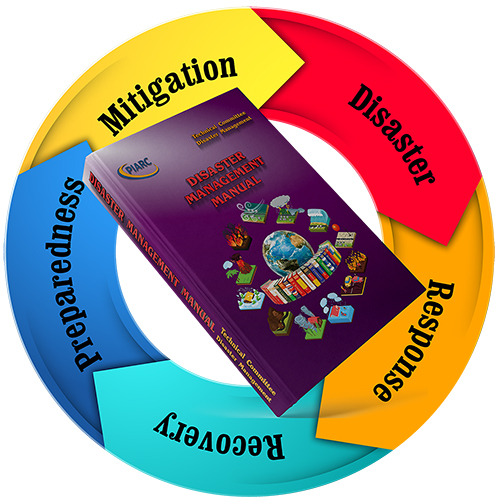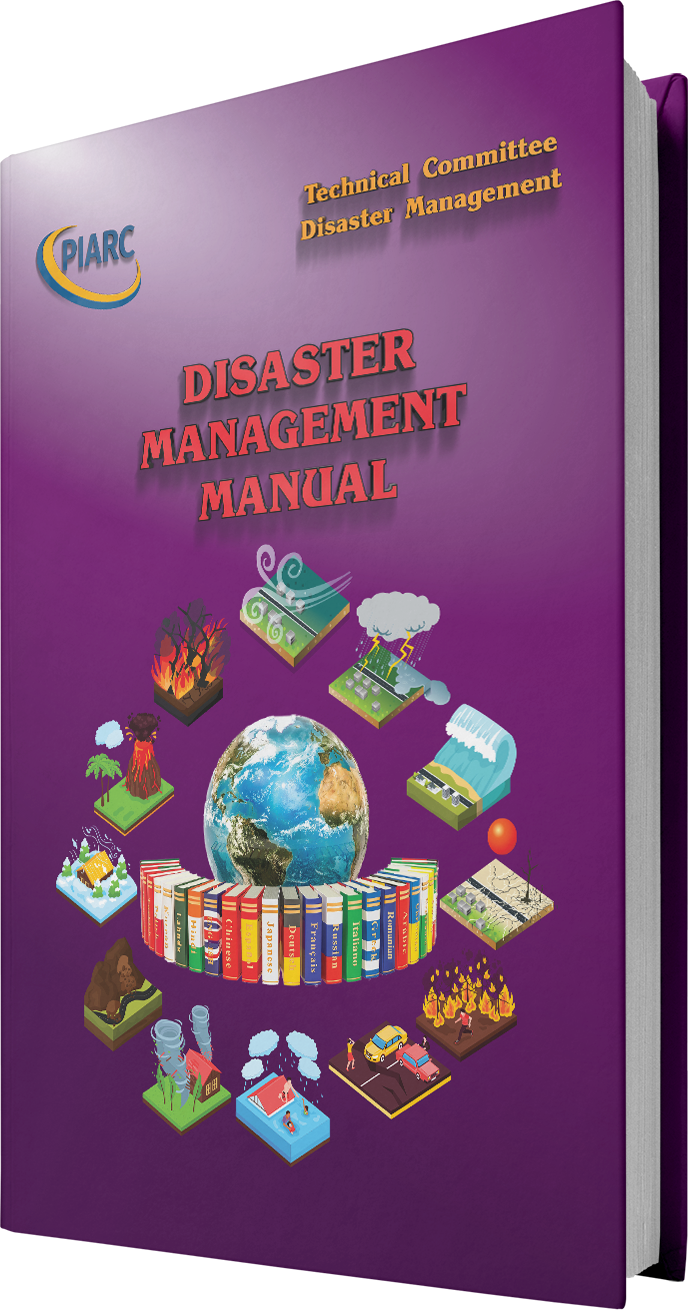
Disaster Management Manual
A manual for practitioners and decision makers!

Disaster Management Manual
A manual for practitioners and decision makers!
Natural disasters such as typhoons, torrential rains, and other wind and flood disasters, as well as huge earthquakes and tsunamis, are random and sudden events that are difficult to predict. However, in preparation for these extreme events, road managers need to develop intervention plans that are effective for the anticipated event in order to protect roads from loss as much as possible and ensure road functionality at all times.
Lessons learned from past events play an important role in disaster management. While they can drive the development of new management strategies and new structural intervention and monitoring techniques, they can also serve as test cases to evaluate the effectiveness of what has been put in place. In this sense, In this sense knowledge sharing among road administrations, as well as practical experience, will be crucial. It is the responsibility of those involved in road management to develop and quickly adopt disaster prevention technologies based on the knowledge and skills gained from past disaster experiences.
Disaster management encompasses a series of activities and actions performed by various actors such as officials, road administrators, technicians, road users, road administrations, etc. who must be trained, coordinated and informed, according to the function that corresponds to them, during every phase of a disaster management (mitigation, preparedness, response and recovery). We live in a society where roads and road networks are required to be resilient in the event of a disaster, but however, road infrastructure alone does not respond to this need and it is necessary that society also act in a resilient manner. In other words, a resilient road network should be supported by an equally resilient social network. From such a perspective, disaster management needs to constantly evolve.
New technical solutions, technological innovations, but also well-trained personnel, well-informed users, well-coordinated organizations, and efficient use of communication within road managers and their peers are crucial in determining a significant reduction of disaster impacts. These matters are cross-cutting issues for the organization. In this sense, it is a crucial issue to share wide variety of technical information related to every disaster management cycle within the road administrations and their associates in world wide.
Countries that experience natural disasters repeatedly "Build Back Better" after each past disaster in order to prevent the next one, and strengthen their disaster preparedness based on this experience. On the other hand, the needs of society have evolved rapidly in recent years due to social diversification and population growth. Disaster management also needs to change its strategies and methods to meet these social changes.
This manual, prepared by the World Road Association (PIARC), provides advice on effective and efficient strategies and methods for PIARC member countries and regions in managing various disasters. This manual presents basic concepts and case studies of lessons learned and experiences gained in applying these basic concepts in practice. These ideas and examples are categorized and provided for each stage of the disaster management cycle.

In addition, it is universally acknowledged that technology has advanced remarkably in recent years. In this manual, the latest disaster reduction technologies that contribute to the promotion of efficient and effective disaster management are summarized as "KIOSK".
KIOSK collects and organizes "Technologies contributing to disaster management" that contribute to damage reduction to prevent the latest disasters, in order to better support disaster management planning in response to social changes and recent disaster situations. The "Technology Contributing to Disaster Mitigation" is being collected and organized. It is expected that the use of these technologies will help other disaster management to be more advanced and enhanced.
We hope that road engineers in each country and region will use this manual as a reference and further evolve the sophistication of disaster management in their respective countries based on new ideas suitable for their countries, and we hope that the disaster management manual itself will also evolve by adding successful examples of them to this manual.
This website is divided into five chapters. Each chapter is made up of group of sections which are the activities that support Disaster management. Each section is made up of themes that describe the technical, institutional and practical issues covered.
This red horizontal toolbar appears at the top of each page and shows the chapters.
To move from page to page you can use the drop-down menus on the brown toolbar (below the banner).
As a basis for providing a consistent approach to implementing this guidance and its recommendations, a framework for road infrastructure asset management has been introduced. This framework sets out the activities that support asset management and that are to be addressed by road organizations as they implement asset management in their organizations. The 20 chapters of the manual describe the activities and are grouped under five main sections (see picture below).
 Section 1 - Management
Section 1 - Management
1.1 Disaster Reduction Framework
1.2 Resilience
1.3 Disaster Management
1.4 KIOSK
Section 2 - Mitigation
2.1 Mitigation Measures
2.2 Structural Measures
2.3 Non-structural measures
2.4 Social capital
Section 3 - Preparedness
3.1 Preparedness Measures
3.2 Business Continuity Planning
3.3 Hazard Identification
3.4 Early Warning
3.5 Training (Drill) and Exercises
Section 4 - Response
4.1 Response Measures
4.2 Information Management
4.3 Coordination and Cooperation
4.4 Evacuation
4.5 Intelligent Transport Systems
4.6 Big Data and Social Network
Section 5 - Recovery
5.1 Common Disaster Recovery
5.2 Uncommon Disaster Recovery
Each of the 20 chapters has a top-level page that outlines the scope of the information provided with options to drill down to detailed topics that are shown in a side menu of the page.
lick on any of the menu items on the left of the page – this will reveal the topics that are associated with the chapter. For example:
The website is illustrated with case studies, reference sources and external links. These are shown in the menu.
The drop-down menu of “Tools” in the top menu provides access to two information pages. You can use the “Search” box alongside "Tools" to enter your search term – either a key word or a phrase in double quote marks.
In the footer of every page there are links to website support, the site map, technical requirements.
KIOSK contains a lot of techniques that will be beneficial to the disaster management to your organizations. KIOSK contains the general idea of each technology. For further information and more detailed information, click "the further information" link button on each technology if you want. You can jump to the external link to the technology showcase gateway of "apan Bosai Platform".
© World Road Association (PIARC).
The contents of this website are copyright – all rights reserved.
Files, images and documents can be freely reproduced provided it is only for personal use, training or education purposes – subject to the following terms and conditions:
PRINTING, PHOTOCOPYING
Printing, photocopying and other means of reproduction for commercial purposes in any form or by any means, electronic or mechanical, is not permitted without permission in writing from the World Road Association (mailing and email addresses below). The permission of the World Road Association is also required to re-use the information for the purposes of publishing, broadcasting or translating into other languages.
DISCLAIMER
While every effort has been made to ensure the accuracy of the contents of this website, the World Road Association cannot be held responsible for any errors or omissions.
Use of a term in this web site should not be regarded as affecting the validity of any trademark or service mark.
The identification of a specific public agency, research entity, or company in no way reflects an endorsement of their research, practices, products, or services.
Please notify the Association of any errors that require correction (mailing and email addresses below).
LANGUAGE VERSIONS
This version of the website is in English. In future it will also be published in French and Spanish. When available, links to each language will be included in the header on each page.
World Road Association (PIARC)
La Grande Arche
Paroi Sud - 5th Floor
F-92055 La Défense Cedex
FRANCE
email: info@piarc.org
Main website: https://www.piarc.org/en/